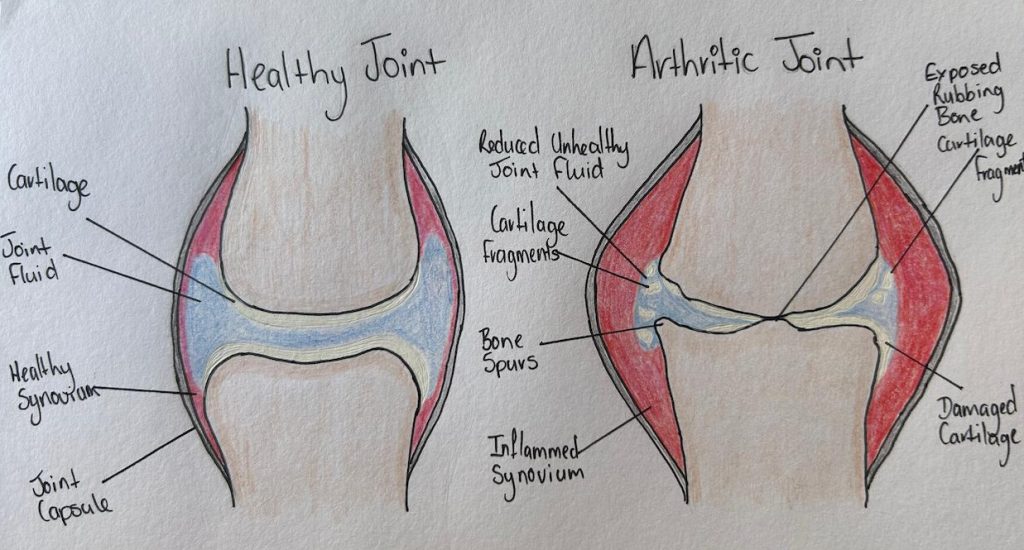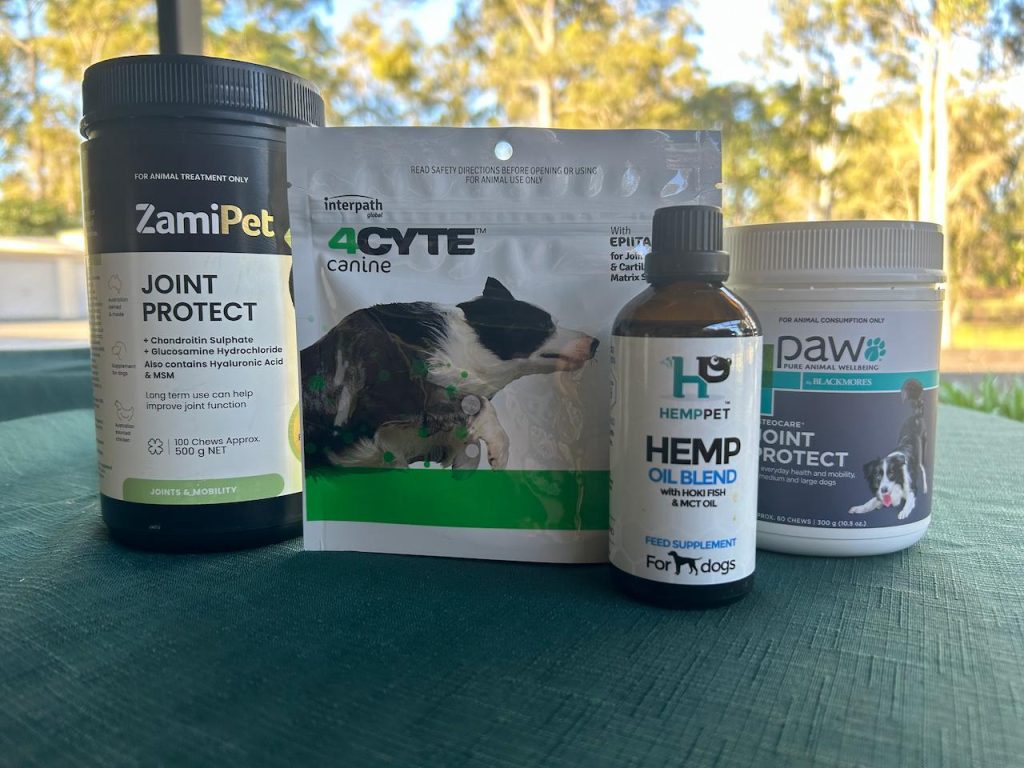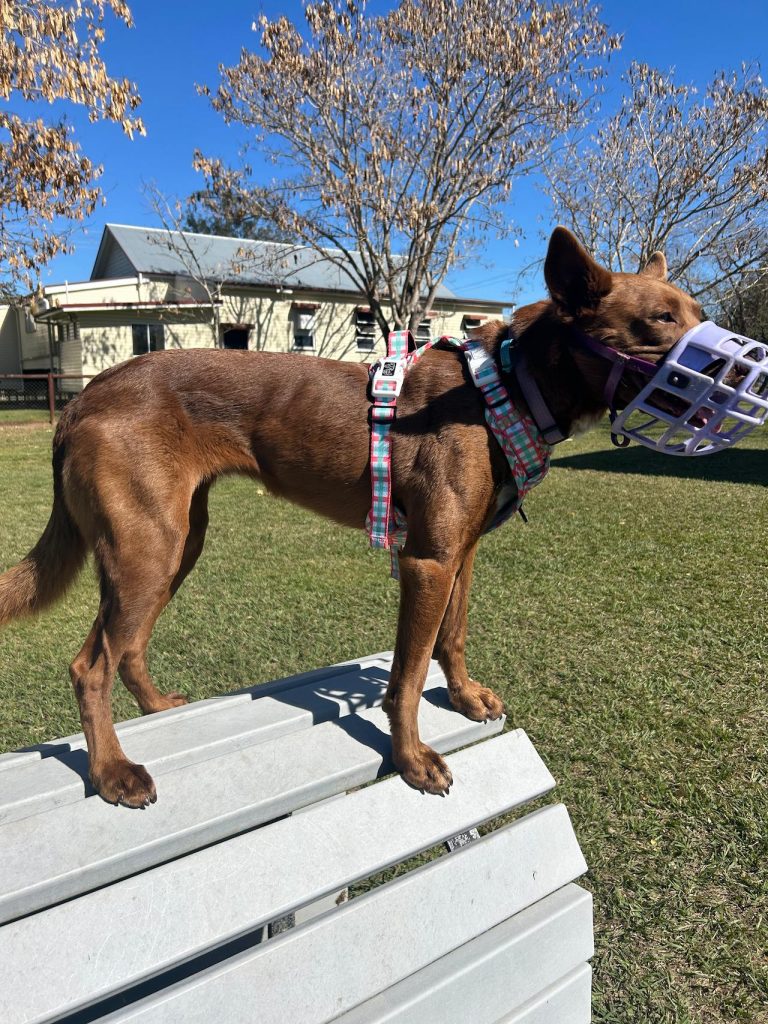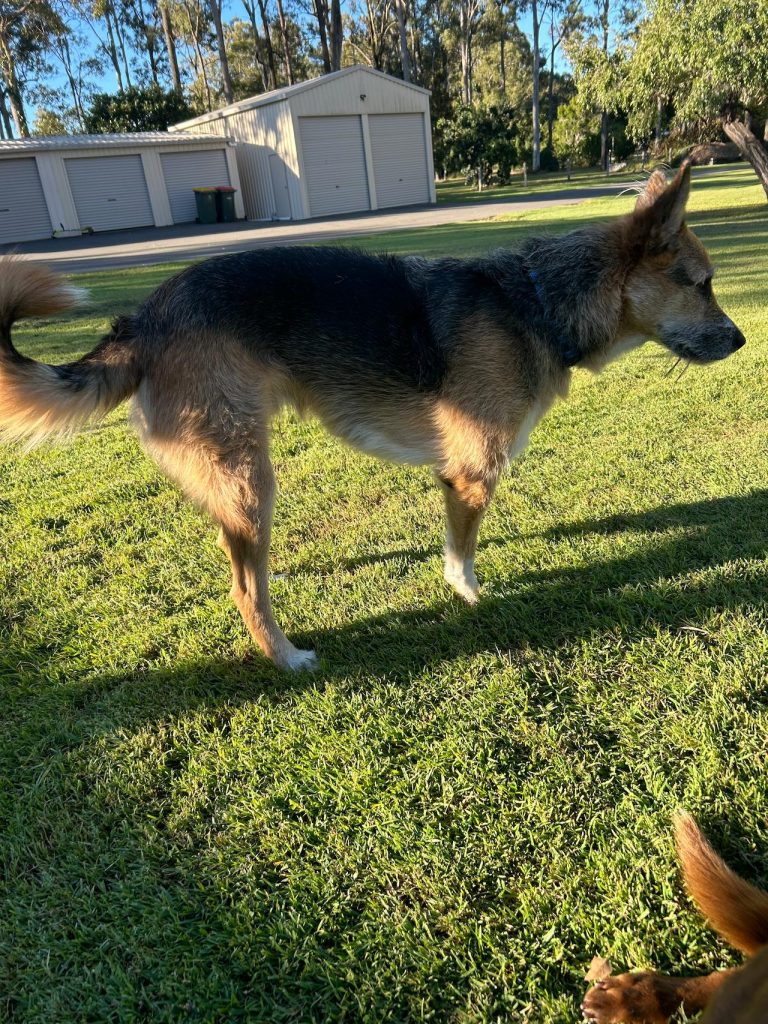Did you know that 1 in 5 dogs over the age of 1 show signs of arthritis? Arthritis is not only a common condition in humans, but for our pets as well, affecting around 80% of senior dogs. It is a painful, progressive and incurable disease that can dramatically affect the quality of life of affected dogs. So how can you help keep your best friend comfortable?
This article delves into arthritis, what causes it, the signs, diagnosis, treatment and how you can help prevent it from a young age. We will also look at helpful tips to help keep your arthritic dog comfortable and improve their quality of life.
Contents
•What is Arthritis?
•What Causes Arthritis?
•Where Does Arthritis Develop?
•What Breeds are Prone to Arthritis?
•Signs of Arthritis
•Diagnosis of Arthritis
•Treatment of Arthritis
•Prognosis of Arthritis
•Prevention of Arthritis
What is Arthritis?
Arthritis refers to joint inflammation with the most commonly seen arthritis in dogs being Osteoarthritis (OA). Osteoarthritis describes both the inflammation and degeneration of one or more joints that leads to pain in the affected joints. Many dogs affected by arthritis will experience the condition in multiple joints, called Polyarthritis. Due to the amount of pain in affected joints, dogs suffering from arthritis have a decreased range of movement and it often limits their ability to perform everyday activities.
Two other types of arthritis also exist. Immune-mediated arthritis is an auto-immune condition where the immune system attacks the joints. In humans it is called Rheumatoid Arthritis, but it is extremely rare in dogs. There is also Septic Arthritis, which is the result of an infection within the joint, that causes inflammation. These are most commonly bacterial, but can also be the result of a fungal infection or tick-borne disease like Ehrlichia.
What Causes Arthritis?
A healthy joint involves a layer of cartilage and joint fluid (synovial fluid) to act as a cushion and allow the smooth movement of the joint. Damage to the cartilage and loss of the lubricating abilities of synovial fluid causes a release of inflammatory factors which worsen the joint disease. This prevents smooth movement within the joint and eventually areas of exposed bone will start to rub together, causing severe pain. The diagram below shows a healthy joint compared to an arthritic joint which has damaged cartilage, exposed bone, inflammation in the synovial fluid and swelling of the joint.

- Cartilage damage is the result of general wear and tear throughout life, however, there are a number of factors that contribute to the development and progression of arthritis, including:
- Body conformation/shape
- Body condition/weight
- Abnormal joint development (e.g. Hip Dysplasia, Luxating Patellas, Elbow Dysplasia, etc)
- Injury to a joint or associated bones/muscles/ligaments
- Dietary history and nutritional imbalance
- Orthopaedic surgery
- High impact activity
- Infection with bacteria, fungi or tick-borne disease (Septic Arthritis)
- Immune-mediated Arthritis
Old age alone does not cause arthritis. Rather, most of the dogs that suffer from arthritis are affected by a combination of the above factors.
The leading cause of arthritis in dogs is being overweight or obese!
Where Does Arthritis Develop?
Any joint can be susceptible to arthritis, as long as it experiences something that may damage the cartilage. However, in dogs, the most common arthritis locations are hips, stifles (knees), elbows, carpus (wrist), neck and spine.
What Breeds are Prone to Arthritis?

Arthritis is most commonly seen in large breed dogs, due to their rapid joint development and heavier weights, which contribute to many of the factors causing cartilage damage. Many large breeds will start to develop arthritis from an early age and will show signs by one year of age.
However, all dogs can develop arthritis, particularly as they age or if exposed to other contributing factors, like obesity or developmental joint problems. 80% of senior dogs suffer from arthritis, meaning it is one of the most commonly diagnosed disease.
Signs of Arthritis
There can be many signs that a dog may demonstrate if suffering from arthritis, however, the signs tend to be more subtle. Pain is typically an aching type of pain and dogs tend to be quite stoic, so won’t cry or complain about their pain. Instead, commons signs owners may notice are:
- Difficulty getting up and down/rising slowly
- Walking stiffly or a change in gait
- Lameness in one or more legs
- Reluctance to go up or down stairs
- Reluctance to jump or climb
- Reluctance to walk, slow walks or cutting walks short
- Reluctance to be touched in some areas
- Stiff, swollen or sore joints
- A creaking or grinding sound in the joints
- Loss of muscle mass in an affected limb
- Decreased appetite
- Excessively licking an affected area
- Sudden aggression towards dogs or people
- Fever
- Lethargy

If you notice any of these signs in your dog, book them in with your regular vet for an examination.
Diagnosis of Arthritis
Signs of arthritis are often noticed by your vet during a physical examination. This may be a routine examination, such as an annual health check, or if they present to the clinic for signs of arthritis. During a physical examination, the joints are flexed and palpated to assess joint laxity, range of movement, level of pain and feel for crepitus. Crepitus is the grating feel or sound identified when bone and cartilage move against each other and indicates cartilage breakdown.
If your vet suspects arthritis from a physical examination, they may recommend X-rays. X-rays can show changes in the joint space, such as narrowing and calcium deposits. X-rays are also a great way to monitor the progression of joint disease, so your vet may recommend doing these annually.
If your vet has recently performed surgery on your pet, particularly around a joint, they may have been able to visually identify signs of arthritis in the joints.
Where Septic or Infectious Arthritis is suspected, joint fluid will need to be withdrawn and cultured to determine the cause. Pets with Septic Arthritis may show other signs of systemic disease or infection, such as fever and lethargy.
Treatment of Arthritis
Arthritis is progressive and the damage that has already occurred is irreversible. As such, the pain and inflammation associated with arthritis are not treated, but managed. A multi-modal approach is required in order to relieve pain and allow your dog to move freely and comfortably again.
- A multimodal approach to arthritis management involves:
- Weight Management
- Exercise Modification & Physiotherapy
- Environmental Changes
- Joint Supplements & Diet
- Medications
Weight Management
The most important aspect of managing arthritis is to maintain a lean body condition! Obesity is the most prominent cause of arthritis and a shortened lifespan. Obesity can also contribute to health problems like Pancreatitis, Bladder Stones, Respiratory Distress, Diabetes, Cushings, Heart Disease, Kidney Disease, etc.
Reducing weight to a lean body condition significantly reduces lameness and pain associated with arthritis, as well as preventing it from worsening. Weight can be managed through a combination of exercise and diet restriction. A good place to start on restricting the diet is by cutting it by 25-50% depending on how much weight your dog needs to lose. You can also try weight management diets, such as Hills Prescription Metabolic, Royal Canin Veterinary Satiety, Royal Canin Light Weight Care, Hills Science Perfect Weight, Advance Healthy Weight, Black Hawk Healthy Benefits Weight Management. Be sure to check with your vet before using a prescription weight loss diet.
Exercise Modifications & Physiotherapy
Exercise is crucial to improvement in an arthritic pet. Not only does it assist with weight management, but it also maintains mobility, increases muscle mass and improves range of movement. However, the type of exercise is very important.
Avoid high impact activities like running, fetch or hiking. These activities cause heavy impacts to the joints that may worsen arthritis. A warm-up walk should always be undertaken before allowing your dog to do these things.
Instead, consistent, low impact activities are great forms of exercise. A couple of short walks a day or slow paced walks are a great option. The duration of the walk can be slowly increased depending on how well it is tolerated by your dog. Swimming is also a great activity for mobilising the joints. In fact, some dogs may find that swimming or moving in water reduces their pain. At home, set up a consistent exercise routine and maintain it every day to provide benefits to your arthritic dog.
When available, physiotherapy is a great option for arthritic pets and shows promising improvement. Physiotherapy can involve passive stretching, range of movement, controlled walking with obstacles, swimming and underwater treadmills.
Environmental Changes
Joint pain and inflammation associated with arthritis can reduce the range of movement within the joints and lead to muscle atrophy (loss of muscle tone). As such there are a few changes that can be employed around the home to keep your dog feeling comfortable and ease their movement around the house.
Some recommended changes include:
PET STAIRS AND RAMPS
Pets with arthritis may struggle to jump up onto furniture, get into the car or climb stairs within the house. Providing pet stairs can make access to furniture easier while using ramps to access the car or over staircases may provide easier access to these places without placing unnecessary pressure on the joints.
KEEP THEM WARM
Colder temperatures tend to worsen the pain associated with arthritis. When the body is cold, blood vessels and nerves constrict, reducing the supply of blood and nutrients to the joints, which can cause them to become stiff, affects joint fluid and sensitises nerve endings to pain. So get your dog that cute jumper, provide a warm bed for them to snuggle into and keep them inside or sheltered at night through the cooler months.
PROVIDE COMFORTABLE RESTING PLACES
It is common sense that lying on hard surfaces can be painful on the joints and can cause irritation from the pressure. Getting up from the concrete or hard ground can be difficult for arthritic pets, so make sure they have plenty of soft comfortable options to lie on. Some pets may like beds that use memory foam or orthopaedic beds to support their joints and allow them to wake up feeling rested.
ELEVATE BOWLS
There are many benefits to elevated bowls, including ease of access, easier swallowing and reduced risk of vomiting. For pets with arthritis, having an elevated bowl reduces the shifting of weight onto sore joints and makes food and water more accessible, especially on those bad pain days. Provide multiple water bowl options in easily accessible locations so that your dog can get to a bowl whenever they want to.
AVOID SLIPPERY FLOORS
When your pet slips on the floor, this puts additional pressure on their joints as they attempt to compensate and correct themselves, instead of falling over. Because of this pressure, having slippery floors can worsen arthritis. Avoid tiles, polished wooden floors, vinyl and concrete. If you do have slippery floor coverings, try using carpets or rugs to cover them over and prevent slipping. Otherwise, if your dog will allow it, you could try anti-slip booties or you can purchase grip pads for their paws.
Remember keeping the nails short will also assist in preventing slipping on smooth surfaces.
Joint Supplements & Diet

Nutritional intake can impact the development of arthritis, so it is fair to say that managing the diet can also prevent the worsening of arthritis. Ensure that your dog is on a premium quality, nutritionally balanced and complete diet. This may be a premium-quality dry food, fresh pre-prepared diet or a home-made diet, as long as it is nutritionally balanced to meet your dog’s daily needs, including ingredients for healthy joints like calcium and phosphorus. Some diets are also available that are designed specifically to support pets with joint problems, such as Hills J/D, Royal Canin Mobility or non-prescription diets like Advance Healthy Mobility or Black Hawk Joint and Muscles. These diets typically include common joint supplements, but may also assist with weight management.
To ensure your home-made diet is nutritionally balanced it is best to consult with a Veterinary Nutritionist. However, these resources may also be helpful:
- Sydney Animal Nutrition – Consult with a Veterinary Nutritionist
- Veterinary Nutrition Group – Recipes to make at home and combine with a balancer
- Balance.It – Assists in determining how to balance your existing recipes
Joint Supplements can also be added separately to your dog’s regular diet. These are called nutraceuticals and are available over-the-counter. They are best started early in arthritis management to slow down the progression of arthritis. They can form the building blocks of cartilage, reduce destructive enzymes and enhance joint fluid. As these supplements are not regulated as closely as prescription medications, they are not all created equally. Additionally, individuals may have varied responses to the same product. You may need to try a couple to find what works for your dog.
Some common, recommended ingredients are:
OMEGA FATTY ACIDS
Omega fatty acids, particularly omega-3’s or EPA, has been shown to be highly effective, and possibly the most effective, supplement for relieving joint pain. Omega fatty acids have anti-inflammatory properties and assist in nourishing the joint. Fish Oil is a great source of omega-3’s that is accessible to our dogs and is readily available. Sardines, Salmon and Mackerel tend to be the types of fish with the highest fish oil content.
GLUCOSAMINE/CHONDROITIN
Glucosamine and Chondroitin are both common supplements and often used together. They possess anti-inflammatory properties that have proven beneficial in reducing pain and reliance on anti-inflammatory medications.
Green Lipped Mussel is another supplement that falls into this category. It is high in chondroitin which exists within joint connective tissues, as well as omega fatty acids to provide anti-inflammatory properties.
Dr Brittany’s top recommended glucosamine, chondroitin and green lipped mussel products are: PAW Blackmores OsteoSupport, Glyde and Sashas Blend
EPIITALIS
Epiitalis is a seed extract oil from the plant Biota Orientalis. Epiitalis has been shown to stimulate the production of healthy cartilage, assist in repairing damaged joints and suppress inflammatory markers within the joint. Epiitalis is used exclusively within the 4Cyte range.
4Cyte is Dr Brittany’s number one recommendation for a joint supplement after noticing a massive improvement in Foster’s mobility after starting the product.
ROSE HIP POWDER
Rose Hip Powder is a plant-based supplement that possesses anti-inflammatory properties, associated with reducing the presence of inflammatory white blood cells around inflamed areas. It also has cartilage protecting properties and is used readily in both human and animal medicine.
Medications
As arthritis is a painful condition, pain medications are often required to relieve the pain associated with the disease, especially as it progresses. Pain relief can help to improve the quality of life of arthritic pets and allow them to get back to some normal activity.
NSAIDS
The most commonly prescribed medication for joint pain is Non-Steroidal Anti-inflammatory Drugs. These medications can include Meloxicam, Previcox, Carprofen and Galliprant. NSAIDs are highly effective pain relievers. They stop the release of destructive molecules (prostaglandins) by blocking inflammatory pathways. They have been used and studied extensively in the relief of osteoarthritis and do not show any evidence of impacting the progression of arthritis.
While effective, NSAIDs have been associated with side effects, particularly after long term use. Common side effects can include vomiting, diarrhoea, blood in stool/vomit or malena (black, tarry faeces), lethargy or decreased appetite. If you notice any of these symptoms, stop the medication immediately and consult your veterinarian. For pets that are on these long term, a regular blood test, typically 6 monthly, is recommended to monitor the response of the liver and kidneys, which are responsible for processing these medications.
PENTOSAN POLYSULFATE SODIUM
Pentosan Polysulfate Sodium is an injectable arthritis medication marketed under the name Cartrophen or Zydax. This is typically administered by a vet under the skin and is given as a weekly injection for 4 weeks, then becomes monthly. It works by stimulating cartilage production and repair by activating chondrocytes. It also increases the amount and quality of synovial fluid by activating the cells responsible for producing synovial fluid.
Cartrophen has a low incidence of side effects and can be used long-term with relative safety. Reported side effects are usually mild and short-lived, such as injection site pain, vomiting, diarrhoea or lethargy that are gone within 48 hours. In humans, Pentosan Polysulfate is prescribed for the treatment of Interstitial Cystitis (inflammation of the bladder wall), so does not carry the side effects to the kidneys seen with NSAIDs.
BERANSA
Beransa is a more recent release in the Veterinary field that has shown promising results for arthritic patients. It relies on monthly injections of Anti-NGF Monoclonal Antibodies. NGF, or Nerve Growth Factor, is a common signalling protein that is released when inflammation is present, including in the joints, to trigger a pain response. It also increases the sensitivity of the surrounding tissues to pain.
Monoclonal antibodies are produced to attack something that the body normally doesn’t recognise as foreign, in this case NGF. By targeting, binding too and reducing the action of NGF, Beransa can reduce the level of pain registered from an arthritic joint. Anti-NGF Monoclonal Antibodies don’t stop the development of arthritis and in studies in rabbits has been shown to worsen arthritis.
Beransa is intended to avoid the side effects of NSAIDs, but has some of its own. Most commonly is heat, swelling at the injection site, with other side effects like urinary incontinence and neurological signs being rarer. Generally it is considered safe for most dogs. It is recommended for use in senior dogs with severe arthritis that are not responding to NSAIDs and it is not recommended for use alongside NSAIDs, but can be given with other pain reliefs like Pentosan or those below.
If you would like to read more about Beransa, check out the Zoetis Information Page.
OTHERS
Other medications that may be prescribed by your vet to assist with arthritis pain are Tramadol and Gabapentin. Tramadol is a synthetic opioid that lacks the typical side effects associated with opioids and can be used long term for stronger pain relief. Gabapentin is a nerve-acting pain relief with anxiety relief and sometimes sedative properties. Your vet will discuss these options with you depending on your pet’s personal situation and treatment response.
Other Treatments
There are other treatment options that your vet may discuss with you, depending on your individual dog and your circumstances. These may include surgery, injections into the joints, immunosuppressants (for immune-mediated arthritis), acupuncture, or laser therapy. These treatments are often less commonly used due to necessity or accessibility. Some of these need to be performed by trained or specialist personnel.
Prognosis of Arthritis
Sadly, arthritis is an incurable, progressive disease. This means that your dog’s arthritis will continue to worsen overtime. However, following the above management steps can help your dog to continue to live a comfortable, full life.
Prevention of Arthritis
Because arthritis is incurable, prevention is the best treatment option available. Prevention can be started as soon as you bring your new puppy home.
Weight Management
As carrying excess weight is a leading cause of arthritis, managing your dog’s weight throughout their life is the key method of preventing arthritis. The best way to determine if your dog is at a healthy weight is using body condition scoring. A healthy body condition is a 4-5/9. In healthy weight dogs, they should have a visible waist from both the top and side view. Their ribs should be palpable and feel similar to the bones of the back of your hand with light touch. If their ribs feel like your knuckles, they are underweight and if they feel like your palm then they are considered overweight.
To assist, Royal Canin have an excellent Body Condition Scoring Chart. Below is the Medium Dog.

Below I have also included images of both my dogs as a reference. Eve (left) is a lean dog graded at 4/9. Foster (right) is also lean, but has a long coat that conceals his figure. On palpation though, his BCS is a 5/9.


Controlled Exercise
The amount and type of activity that your dog does can increase their risk of arthritis. Activities like running, jumping and hiking can be high impact activities that put increased pressure on the joints. It’s a good idea to warm-up with a walk before doing these activities and to limit the amount of time your dog does them for each day.
Growing puppies should not be expected to or taught to participate in high impact activities until their joints are developed. Puppies should not jump prior to 6 months of age, but small jumps (not above their elbow height) may be ok between 6-12 months and they definitely shouldn’t be doing any competitive jumping until at least 12-15 months, especially in large breed dogs.
If you would like to start activities like fetch or agility with your puppy, you can certainly start teaching them the basics of these activities, like picking up toys, returning them, walking through tunnels or onto platforms (as long as they aren’t jumping off) and even stepping over bars.
Correct Diet
By a correct diet, I mean a nutritionally balanced and complete diet, especially one that suits your dog’s breed size. For large breed puppies, it is essential to provide a large breed puppy suitable diet with an appropriately balanced calcium and phosphorus content. A nutritionally balanced and complete diet will ensure that your dog is getting all the nutrients they need for the bones to grow, joints to develop and repair and to nourish their joint fluid.
Joint Supplements
Joint supplements can be started at any age. Because they can provide the building blocks for cartilage and assist in nourishing the joints, they can be started at a young age to assist in preventing the development of arthritis and slowing the development of it.


